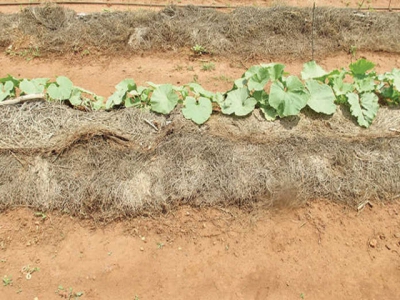Mulch ado about no-till

No-till farmers have always known that leaving a layer of crop residue on the soil surface increases the humus content.
Pumpkins growing next to a strip of mulch. Photo: Bill Kerr
But they have also found other benefits to the practice.
There are several cases of no-till farmers experiencing fire on their lands and extinguishing it before it passed through the entire lands.
The fires destroyed the mulch, and the difference in the following crop between the burnt and unburnt sections was significant, with the yield and plant health in the burnt section being significantly inferior.
A no-till farmer can also use mulch if the cropping schedule permits. In my case, I have a fair amount of unused ground in winter and plant two rows of grazing vetch on the beds.
This crop grows waist-high and provides a mass of high-quality mulch as well as 120kg nitrogen (N) per hectare in the planted area. It’s important to prevent the crop from setting seed, however, or it may become a weed.
So when the pods are forming but not mature, I rake the vetch up onto the beds from either side. I then use a spade to cut the plants at ground level. This is quick and easy.
I am left with a 50cm wide mulch strip in the middle of the beds and plant on either side of this layer. Apart from the N produced on the root nodules, the high protein foliage is also full of N and an excellent food for earthworms and an array of other soil organisms.
Vetch makes ideal humus, and the mulch is too thick for weeds to penetrate until it has broken down. This system has worked extremely well for me and is a good source of N for organic producers.
Which Crop?
The choice of which cover crop to use as mulch depends both on the climate and season. A legume is preferable as it sources much N from the air and far more humus is formed for the volume of carbon in the material than is the case with non-leguminous crops.
This means there is enough N for the requirements of the crop and to maximise humus formation.
Grazing vetch does well during the Highveld winter, and March and early April are the ideal time to plant it. It covers the entire land, making weed growth less of a problem in winter. In warmer areas, dolichos beans are a good option for summer production and winter vegetables.
Increasing demand
If you are a non-organic farmer and thinking of growing mulch, killing it off with herbicide and planting into the dead mulch, be warned – this does not work. Winter legumes such as vetch, serradella and a number of clovers are all fairly resistant to glyphosate and paraquat.
Organic farmers have no option but to employ mechanical weeding. Using no-till with this type of mulching and not allowing weeds to set seed ensures that the weed population steadily decreases. This reduces costs and makes the enterprise easier to manage.
As mentioned in a previous article, this system is ideal for organic producers and small farmers unable to afford a tractor and implement for conventional tillage.
No-till, especially with a cover crop mulch on a section every year, is the ideal solution for organic farmers to grow healthy crops at lower cost.
You should be able to sell organic vegetables at the same price as conventionally grown crops. In so doing, you will increase the demand for organic vegetables.
Có thể bạn quan tâm
 No-till vegetables: how to grow them
No-till vegetables: how to grow them No-till vegetable production is not practical for everyone and is more suited to the small-scale organic farmer.

